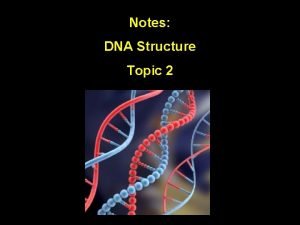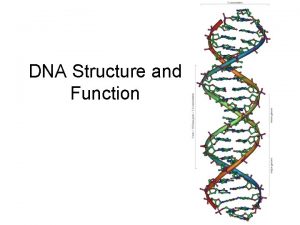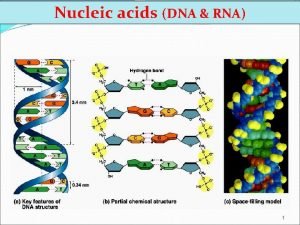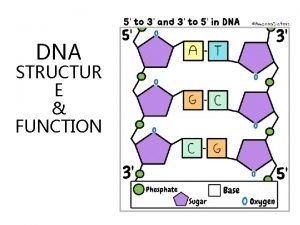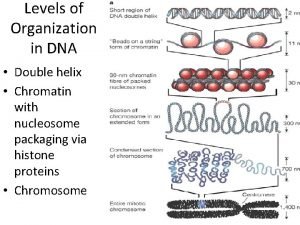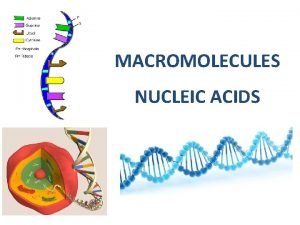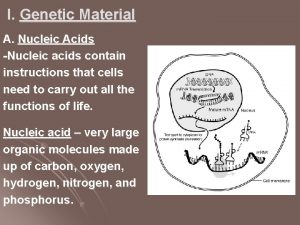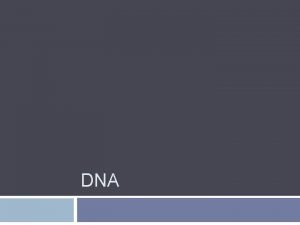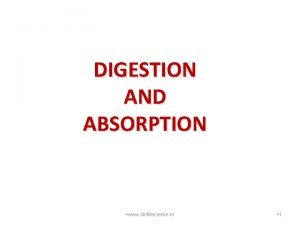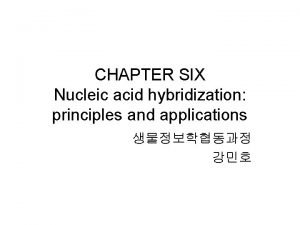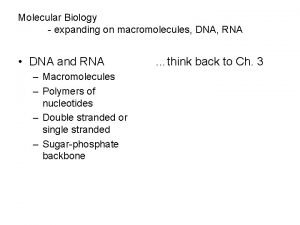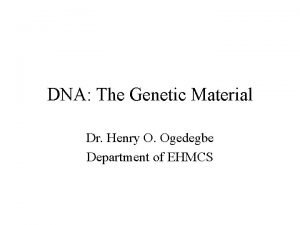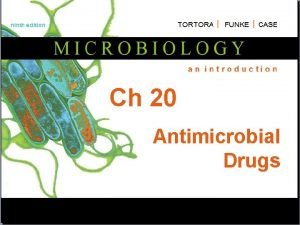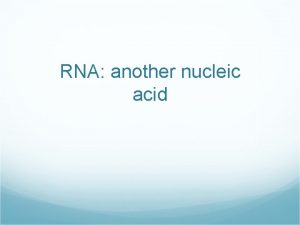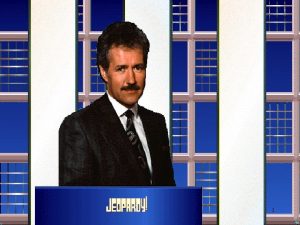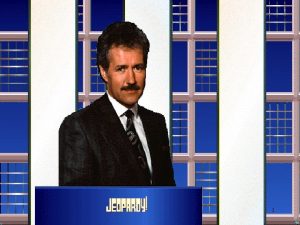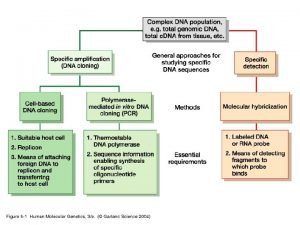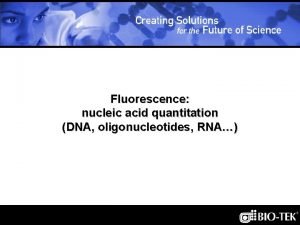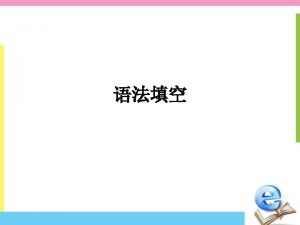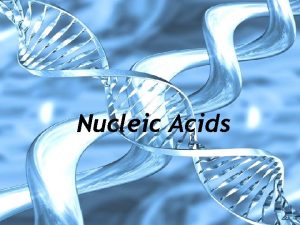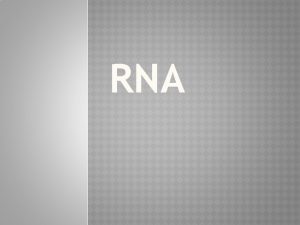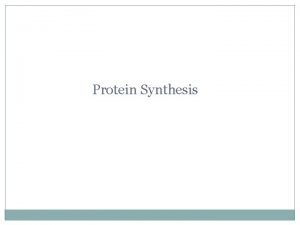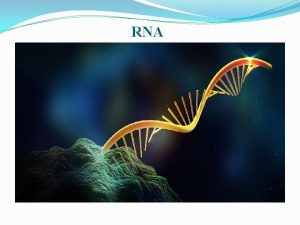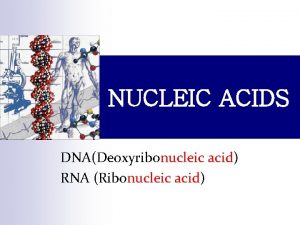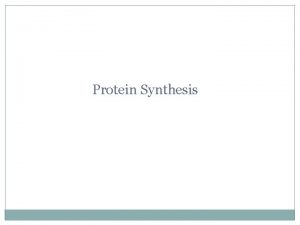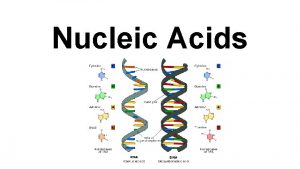RNA Another Nucleic Acid RNA Structure RNA is
















- Slides: 16

RNA Another Nucleic Acid

RNA Structure • RNA is the second type of nucleic acid found in a cell. • There are 3 different types of RNA • Structure of RNA: • Long chain of nucleotides • 5 -carbon sugar called ribose • Phosphate • Nitrogen bases- Adenine, Guanine, Cytosine and Uracil (instead of Thymine) • Just a single strand

Function of RNA • The function of RNA is to carry the code from DNA in the nucleus to the ribosomes in the cytoplasm (where the code will be used to make proteins).

✓ Quick Check • Compare the details of DNA to RNA Feature DNA RNA # of strands 2 1 Type of sugar Deoxyribose Ribose Nitrogen bases A, T, G, C A, U, G, C Location in cell Nucleus → Ribosome in cytoplasm Number of forms 1 3 Job description Carries genetic information Take info from DNA to the ribosomes to make proteins

Types of RNA • Messenger RNA (m. RNA)- this is the piece of RNA that takes the code (“message”) from the DNA to the ribosome. • Transfer RNA (t. RNA)- this RNA brings (“transfers”) amino acids from the cytoplasm to the ribosome/ m. RNA. • Ribosomal RNA (r. RNA)- this is the structural part of a ribosome (a ribosome is only protein and RNA)

Types of RNA

Transcription • Transcription is the process in which a part (gene) of the DNA is copied into m. RNA. • Players • Piece of DNA • Nucleotides • Enzyme- RNA polymerase

Transcription • What happens: • RNA polymerase finds a sequence called the promoter, binds to the DNA and unzips the strands • RNA polymerase “reads” one strand of the DNA and adds the appropriate complementary RNA nucleotides • The product= a single strand of m. RNA

✓ Quick Check • 1. The three types of RNA are m. RN _______t. RNA , A r. RNAand _______ • 2. The process of making RNA from DNA is called transcripti ________. on • 3. m. RNA has to be made from DNA because the DNA cannot leavenucleu the _____ and the s proteins coded for by the DNA areribosome made by the cytoplas ______ which are found sin the m _______. • 4. If the sequence of DNAUCAUCCAG is AGTAGGTCA, what is the m. RNA made from it? U

The Genetic Code • Proteins are continuously made by linking together amino acids. • There are 32 different amino acids. • The sequence of nitrogen bases in DNA and m. RNA determine the order of amino acids in protein. • Codon= the sequence of 3 nucleotides that codes for a specific amino acid. • Anti-codon= the complementary sequence to the codon; it is found on the t. RNA

Codon Chart

✓ Quick Check • Use your amino acid chart to identify the amino acid that goes with each codon. Methionine (start) • 1. AUG __________ Stop • 2. UGA __________ Lysine • 3. AAA __________ • 4. GAG __________ Glutamate • 5. UCA __________ Serine • 6. UCC __________ Serine

Translation • The sequence of nucleotides in m. RNA provides the instructions to the ribosomes for putting together a protein. • Translation- the decoding of an m. RNA message into an amino acid chain (protein). • Parts involved: • m. RNA • Ribosome • t. RNA • Amino acids

Translation • How it’s done: • m. RNA attaches to a ribosome in the cytoplasm • The codon on the m. RNA is “read” by the ribosome. • The ribosome brings in the correct anti-codon with an amino acid attached. • The anti-codon of the t. RNA matches up with the codon on the m. RNA.

Translation • The second codon is “read” and the ribosome brings in the next t. RNA. • A peptide bond forms between the amino acids on the 2 t. RNA’s in the ribosome. • The first t. RNA loses its amino acid and it leaves the ribosome. • The ribosome slides along continuing the process until a STOP codon is reached.

✓Quick Check • Complete the remaining Quick Check in your notes. We will go over the answers in 15 minutes. • http: //www. online-stopwatch. com/countdowntimer/
 Dna labeled diagram
Dna labeled diagram Polymer structure of nucleic acids
Polymer structure of nucleic acids Dna and rna
Dna and rna Chargaff's rule
Chargaff's rule Nucleic acid dna structure
Nucleic acid dna structure Different parts of chromosomes
Different parts of chromosomes Purpose of nucleic acid
Purpose of nucleic acid Nucleic acid building blocks
Nucleic acid building blocks Nucleic acid examples food
Nucleic acid examples food Nucleic acid made up of
Nucleic acid made up of What is nucleic acid composed of
What is nucleic acid composed of Fructose
Fructose Principle of hybridization
Principle of hybridization Nucleic acid made up of
Nucleic acid made up of Nucleic acid chart
Nucleic acid chart Nature of nucleic acid
Nature of nucleic acid Does metronidazole contain penicillin
Does metronidazole contain penicillin
